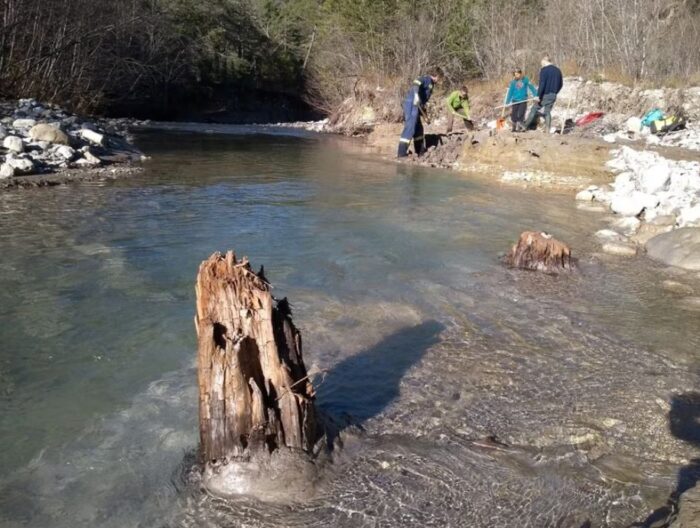Oct 12 2023
Evidence of Ancient Solar Flares
 From time to time the Earth gets hit by a wave of energetic particles from the sun – solar flares or even coronal mass ejections (CMEs). In 1859 a large CME hit Earth (known as the Carrington Event), shorting out telegraphs, brightening the sky, and causing aurora deep into equatorial latitudes. If such an event were to occur today experts are not exactly sure what would happen, but it could take out satellites and short out parts of electrical grids. Interestingly, we have a historical record of how often such events have occurred in the past, mostly from tree rings.
From time to time the Earth gets hit by a wave of energetic particles from the sun – solar flares or even coronal mass ejections (CMEs). In 1859 a large CME hit Earth (known as the Carrington Event), shorting out telegraphs, brightening the sky, and causing aurora deep into equatorial latitudes. If such an event were to occur today experts are not exactly sure what would happen, but it could take out satellites and short out parts of electrical grids. Interestingly, we have a historical record of how often such events have occurred in the past, mostly from tree rings.
A recent study extends this data with an analysis of subfossil pine trees from the Southern French Alps. These are trees partially preserved in bogs or similar environments, not yet fossilized but on their way. Trees are incredibly valuable as a store of historical information because of their rings – tree rings are a record of their annual growth, and the thickness of each ring reflects environmental conditions that year. Trees also live a long time – the Scots Pines used in the study live for 150-300 years. You can therefore create a record of annual tree rings continuously back in time (dendrochronologically dated tree-ring series) by matching up overlapping tree rings from different trees. We have such records going back about 13,000 years.
Tree ring also record another type of data – carbon 14-carbon 12 ratio. This is the basis of carbon 14 dating. The atmosphere has a certain ratio of carbon 14-12 which is reflected in living things that incorporate carbon into their structures. When the living thing dies, the clock starts ticking, with C14 decaying into C12, changing the ratio. One wrinkle for this method, however, is that the C14-12 ratio in the atmosphere is not fixed, it can fluxtuate from year to year. Essentially cosmic rays hit nitrogen (N14) atoms and convert them into carbon 14 in the upper atmosphere. This creates a steady of C14 in the atmosphere (and why it has not all decayed to C12 already).
Cosmic rays are extremely steady, the background radiation of interstellar space. But the solar wind blocks some of them, and therefore solar activity can influence the amount of cosmic rays that reach Earth and convert N14 into C14. This might mess with our carbon dating – but tree rings come to the rescue. Tree rings provide a record of atmospheric C14-12 ratios that we can use to calibrate our carbon dating. This is because we can know the exact calendar year of tree rings from the overlapping record which includes modern trees. So scientists can make adjustments to their carbon dating based on this tree ring record. Pretty awesome.
This tree ring data also provides a record of solar activity, and that is where the new study comes in. They found:
The resulting Δ14C record exhibits an abrupt spike occurring in a single year at 14 300–14 299 cal yr BP and a century-long event between 14 and 13.9 cal kyr BP.
So there was a spike in C14 about 14,300 calendar years before present. This was followed by 100 years of increased background C14. What was going on? They hypothesize that around 14,300 years ago there was a massive CME, something probably 10 times as powerful as the Carrington Event. After such a large CME, solar activity went into a minimum cycle for about a century, allowing more cosmic rays to hit Earth.
The first such spike in the C14 tree ring data was identified for the year 774 CE. This was confirmed to be a global event by tree ring data from around the world. A global energetic event was also confirmed by looking at other cosmogenic isotopes (10Be and 36Cl) in ice cores from Greenland and Antarctica. So there are multiple lines of evidence confirming such an energetic event. The latest study adds to this record with the oldest and most powerful event recorded. Part of their work was to extend the dendrochronologically dated tree-ring record using the Scots Pines data.
The record indicates that there have been 9 such large CME type events in the last 15,000 years. The timing appears to be random without a clear pattern. So we have a little less than 1% chance per decade of such an event occurring now. That is low, but not negligible. There is about a 10% chance of a large Carrington level event over the next 150 years. We are not currently hardened against such an event. Mainly we would need to harden our satellites and bury and harden the transformers on electrical grids. The largest transformers would take years to replace. Such an event could be more disruptive to the global economy than the COVID pandemic.
At this point we are collectively just rolling the dice, hoping such an event does not happen anytime soon and the technology of the future will render such concerns obsolete. That may or may not be a good bet. Or, while we are upgrading our electrical grids, something we need to do anyway, we could spend some extra money to make them more resilient to a powerful CME event. It’s like insurance – you may never need it, but if you do you are screwed if you don’t have it.






